child seat AUDI Q5 2018 Owners Manual
[x] Cancel search | Manufacturer: AUDI, Model Year: 2018, Model line: Q5, Model: AUDI Q5 2018Pages: 392, PDF Size: 60.56 MB
Page 6 of 392
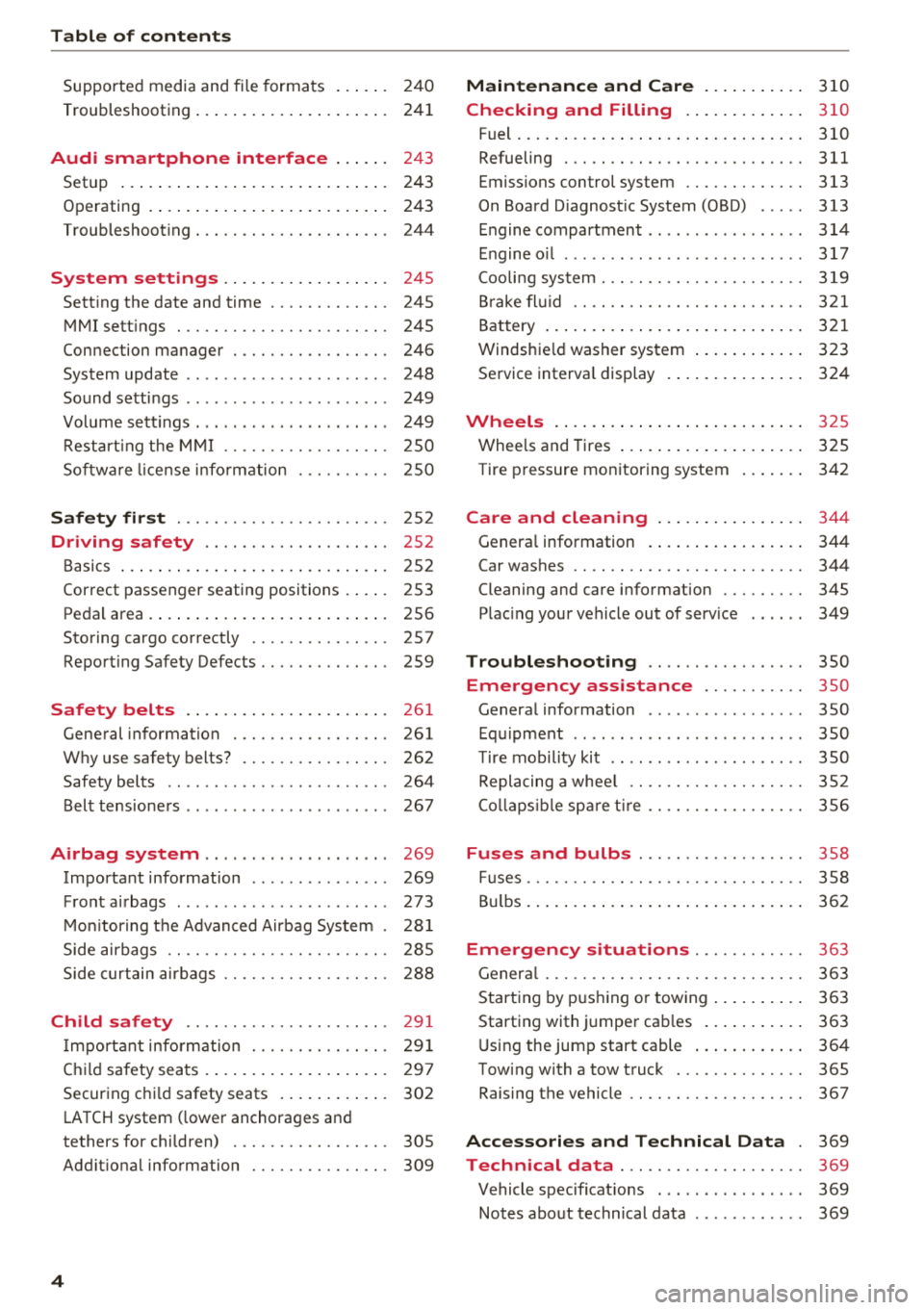
Table of contents
Supported media and fi le forma ts 2
4 0
T roubleshooting . . . . . . . . . . . . . . . . . . . . . 241
Audi smartphone interface . . . . . . 243
Setup ... ...... ... .. ..... ... .. .. ... 243
Op erating . . . . . . . . . . . . . . . . . . . . . . . . . . 243
Troubleshoot ing . . . . . . . . . . . . . . . . . . . . . 244
System settings ... ..... ... .. .. ... 24 5
Sett ing the date and time . . . . . . . . . . . . . 245
MMI sett ings . . . . . . . . . . . . . . . . . . . . . . . 245
Con nection manager . . . . . . . . . . . . . . . . . 246
System update . . . . . . . . . . . . . . . . . . . . . . 248
Sound setti ngs . . . . . . . . . . . . . . . . . . . . . . 249
Volume sett ings . . . . . . . . . . . . . . . . . . . . . 249
R estart ing the M MI . . . . . . . . . . . . . . . . . . 250
Softw are license i nfo rm atio n 250
Safety first . . . . . . . . . . . . . . . . . . . . . . . 25 2
Driving safety . . . . . . . . . . . . . . . . . . . . 2 52
B asics . . . . . . . . . . . . . . . . . . . . . . . . . . . . . 252
Correct passenger seating positions . . . . . 253
Peda l area . . . . . . . . . . . . . . . . . . . . . . . . . . 256
Storing cargo correctly . . . . . . . . . . . . . . . 257
Report ing Safety Defects . . . . . . . . . . . . . . 259
Safety belts . . . . . . . . . . . . . . . . . . . . . . 26 1
Gene ral information . . . . . . . . . . . . . . . . . 261
W hy use safety belts? . . . . . . . . . . . . . . . . 262
Safety belts . . . . . . . . . . . . . . . . . . . . . . . . 264
Belt tensioners . . . . . . . . . . . . . . . . . . . . . . 267
Airbag system . . . . . . . . . . . . . . . . . . . . 269
Important information . . . . . . . . . . . . . . . 269
F ront a irbags . . . . . . . . . . . . . . . . . . . . . . . 273
M on itor ing t he Advanced Airbag System . 28 1
Side airbags . . . . . . . . . . . . . . . . . . . . . . . . 285
Side curtain air bags . . . . . . . . . . . . . . . . . . 288
Child safety . . . . . . . . . . . . . . . . . . . . . . 29 1
I mpo rtant inform ation . . . . . . . . . . . . . . . 29 1
Ch ild safety sea ts . . . . . . . . . . . . . . . . . . . . 297
Securing c hild safety seats . . . . . . . . . . . . 302
L A TCH system (lower anchorages and
tethers for chi ldren) . . . . . . . . . . . . . . . . . 305
Addit ional information . . . . . . . . . . . . . . . 309
4
Maintenance and Care . . . . . . . . . . . 3 10
Checking and Filling . . . . . . . . . . . . . 310
Fuel... ... .. .. .... .. ... .. ..... ... .. 310
Refueling . . . . . . . . . . . . . . . . . . . . . . . . . . 311
Emissions control system . . . . . . . . . . . . . 313
On Board D iagnost ic System (OBD) . . . . . 313
E ngine compartment .. ............... 314
Engine o il .... ... .. .. ............... 317
Cooli ng sys tem. .. .. .. ............. .. 319
B rake fl uid . . . . . . . . . . . . . . . . . . . . . . . . . 32 1
Battery . . . . . . . . . . . . . . . . . . . . . . . . . . . . 3 21
Windshie ld washer system . . . . . . . . . . . . 3 23
Service interva l display 324
Wheels
.. .. .. .... .. ... .. ..... ... .. 3 25
Whee ls and Tires . . . . . . . . . . . . . . . . . . . . 325
Tire p ressure mo nitoring system 342
Care and cleaning . . . . . . . . . . . . . . . . 3 44
Genera l information . . . . . . . . . . . . . . . . . 344
Car washes . . . . . . . . . . . . . . . . . . . . . . . . . 344
Cleaning and care i nfo rmation . . . . . . . . . 345
Plac ing your vehicle out of serv ice . . . . . . 349
Troubleshooting . . . . . . . . . . . . . . . . . 350
Emergency assistance . . . . . . . . . . . 350
General information . . . . . . . . . . . . . . . . . 350
Eq uipment . . . . . . . . . . . . . . . . . . . . . . . . . 350
T ire mobility ki t . . . . . . . . . . . . . . . . . . . . . 350
Repla cing a whee l . . . . . . . . . . . . . . . . . . . 352
Co llapsibl e sp are t ire . . . . . . . . . . . . . . . . . 356
Fuses and bulbs . . . . . . . . . . . . . . . . . . 3 58
F u ses ..... .. .. .. .. .. ............. .. 358
B ul bs . . . . . . . . . . . . . . . . . . . . . . . . . . . . . . 3 62
Emergency situations . . . . . . . . . . . . 3 63
Gener al . . . . . . . . . . . . . . . . . . . . . . . . . . . . 363
Start ing by p ushi ng o r tow ing . . . . . . . . . . 3 63
Starting with jumper cab les . . . . . . . . . . . 363
U sing the jump start cable . . . . . . . . . . . . 364
Towing with a tow truck . . . . . . . . . . . . . . 365
Raising the vehicle . . . . . . . . . . . . . . . . . . . 367
Accessories and Technical Data . 369
Technical data . . . . . . . . . . . . . . . . . . . . 369
Vehicle specificat ions . . . . . . . . . . . . . . . . 369
Notes about technical data . . . . . . . . . . . . 369
Page 58 of 392
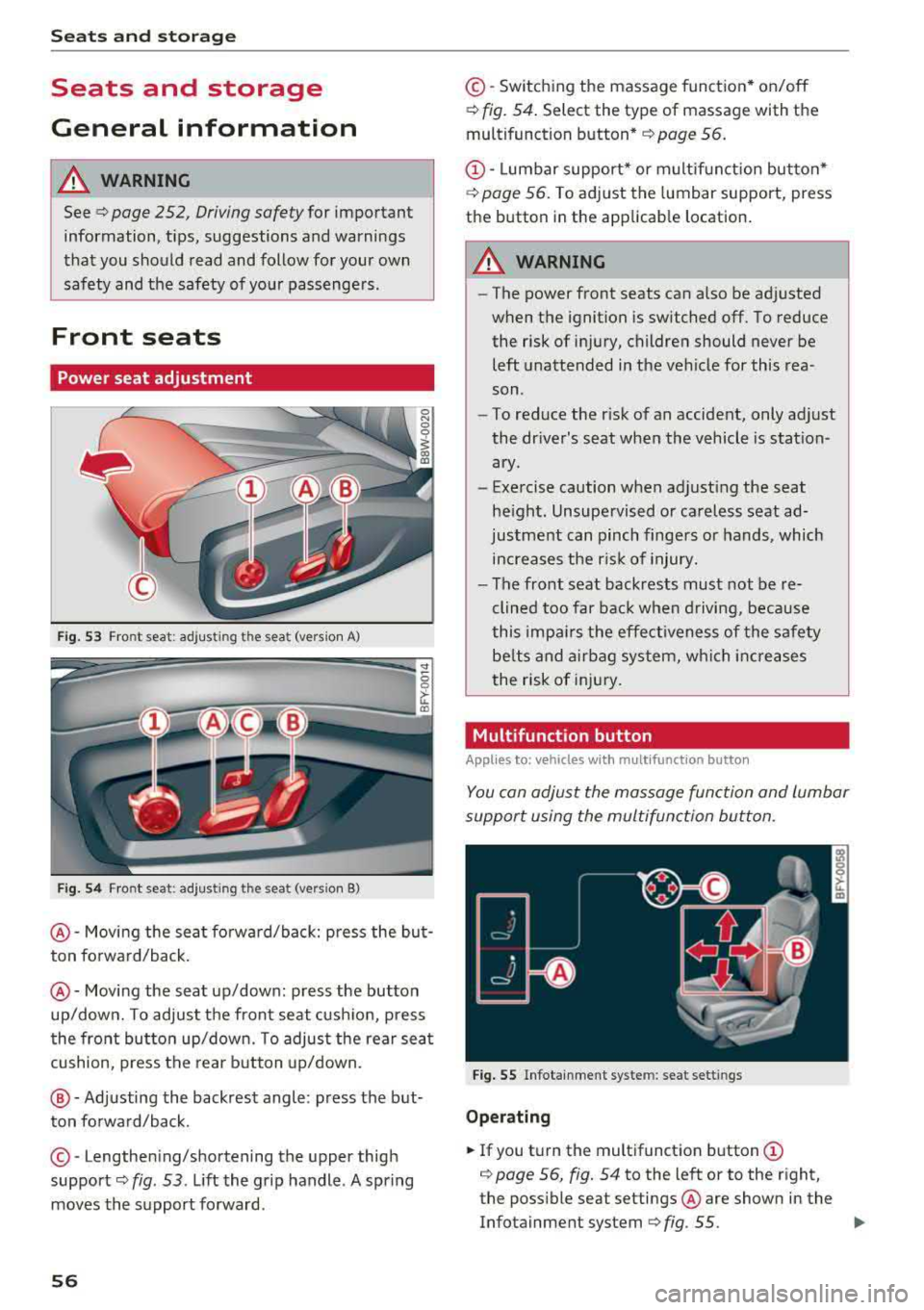
Seats and stor age
Seats and storage
General information
A WARNING
See c> page 252, Driving safety for important
information, tips, suggestions and warnings
that you should read and follow for your own
safety and the safety of yo ur passengers .
Front seats
Power seat adjustment
Fig. 53 Front seat : adjust ing the seat (vers ion A)
Fig. 54 Fro nt seat: adjusting the sea t (vers ion B)
@ -Movi ng the seat fo rwa rd/back: press the but
ton forwa rd/back .
@-Moving the seat up/down: press the button
up/dow n. To adjust the front seat cush ion, press
the front button up/down. To adjus t the rear sea t
cushion, press the rear b utton up/down.
@ -Adjusting the backrest angle : press the but
ton fo rward/back.
© -Lengthe ning/shortening the upper thigh
support
c> fig . 53 . Lift the grip handle . A spring
moves the su pport forward .
56
©-Switching the massage funct ion* on/off
c> fig. 54. Select the type of massage with the
multifunction button *
c> page 56.
CD-Lumbar support* or m ultif unction button*
c> poge 56. To ad just the lumbar support, press
the button in the applicab le location .
A WARNING
-The power front seats can also be adjusted
when the ignition is switched off. To reduce
the risk of injury, children should never be
left unattended in t he vehicle for this rea
son .
-To reduce the r isk of an accident, only adjust
the driver's seat when the vehicle is station
ary .
-Exe rcise caution when adjust ing the seat
he igh t. Unsupe rvised or ca reless seat ad
justment can pinch finge rs or hands, which
increases the r is k of injury.
- The front seat backrests must not be re
clined too far bac k when d riving, beca use
this impa irs the effect iveness of the safety
be lts and a irbag sys tem, w hich i ncreases
the risk of inj ury.
Multifunction button
App lies to: vehicles wi th mult ifunc tion butto n
You con adjust the massage function and lumbar
support using the multifunction button.
Fig . 55 Infotainment system: seat sett ings
Op erating
... If you tu rn the multifunction button CD
c> page 56, fig. 54 to the left or to the right,
the poss ible seat settings @are shown in the
Infotainment system
c> fig . 55. ..,
Page 61 of 392
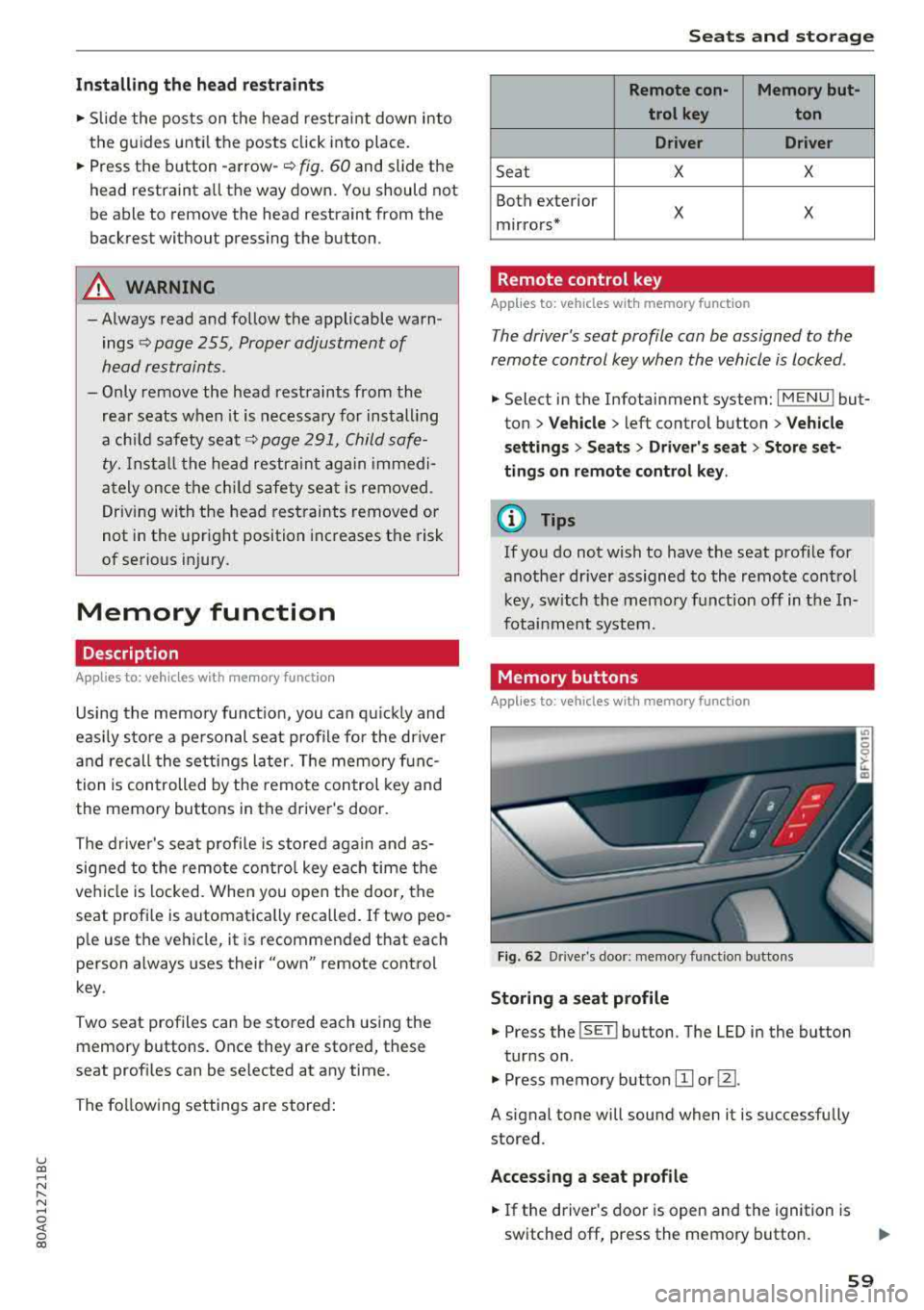
u co ..... N r-N .....
~ 0 co
Installing the head restraints
.,. Slide the posts on the head restraint dow n into
the gu ides unt il the posts click into place .
... Press the button -arrow-c::> fig. 60 and slide the
head restraint all th e way down. You should not
be able to remove the head restraint from the
backrest without pressing the button.
A WARNING
-Always read and follow the applicable warn
ings
c::> page 255 , Proper adjustment of
head restraints .
-Only remove the head restraints from the
rear seats when it is necessary for install ing
a ch ild safety sea t
c::> page 291, Child safe
ty. Install the head restra int aga in immedi
ately once the chi ld safety seat is removed .
Driv ing with the head restraints removed or
not in the upright position inc reases the risk
of serious inj ury.
Memory function
Description
Applies to: vehicles with memory function
Using the memo ry funct ion, you can qu ickly and
eas ily store a pe rsonal seat profile for the dr iver
and recall the setti ngs later. The memory f unc
tion is controlled by the remo te control key and
the memory buttons in the drive r's door.
The drive r's seat p rofile is stored again and as
signed to t he remote contro l key each time the
ve hicle is locked. When you open the door, the
seat prof ile is automatica lly reca lled . If two peo
p le use the vehicle, it is recommended that each
person always uses their
"own" remote control
key .
Two seat profiles can be stored each using the memory buttons . Once they are stored, these
seat profi les can be se lected at any time.
The fo llow ing settings are stored :
Seats and storag e
Remote con- Memory but-
trol key ton
Driver Driver
Seat X X
Both exterior
mirrors*
X X
Remote control key
Applies to: vehicles with memory function
The driver's seat profile can be assigned to the
remote control key when the vehicle is locked .
... Select in the Infotainment system: I MENU! but
ton
> Vehicle > left control button > Vehicle
setting s > Seat s > Driver's seat > Store set
ting s on remote control ke y.
(D Tips
If you do not wish to have the seat prof ile for
anothe r dr iver assigned to the remote control
k ey, sw itch the memory f unction off in the In
fotainment system.
Memory buttons
Applies to: vehicles with memory function
Fig. 62 Drive r's doo r: memory funct io n bu ttons
Storing a seat p rofile
... Press the ISET I button. The LED in the button
tur ns on .
.,. Press memory button IT] or@.
A signal tone will sound when it is successfully
stored.
Acces sing a seat profile
... If the driver's door is open and the ignition is
switched off, press the memory button .
59
Page 62 of 392

Seats and stor age
,.. If the driver's door is closed or the ignition is
switched on, press and ho ld the memory but
ton until the seat adjustment is comp lete.
A WARNING
- For safety reasons, the seat setting can only
be recalled when the vehicle is stationary to
reduce the risk of an accident.
- In an emergency, seat adjustment operation
can be stopped by press ing the
ISETI button
or the buttons @or@
¢ page 56, fig . 54.
Power sources
F ig . 63 12 vo lt socket and USB ports *
When the ignition is switched on, you may be
ab le to use the e lectr ic power sources for exter
nal devices, depending on the vehicle equipment.
12 volt so ckets CD
The 12-volt sockets can be used for elec trical ac
cessories. The power usage must not exceed
120 watts.
The 12 vo lt socke ts a re in the front center con
sole *, in the rear * and on the luggage compar t
ment side trim panel* .
USB ports@
You can cha rge mobi le devices and/or connect to
the Audi music interface* us ing the USB ports*.
For addit ional i nfo rmation abou t the USB ports,
see
¢ page 231, Multimedia connections.
A WARNING
Incorrect usage ca n lead to serious injuries or
burns. To reduce the r is k of injur ies, neve r
60
leave children unattended in the vehicle wit h
the vehicle key.
(D Note
- Dis co nnect the connectors from t he power
sources carefu lly to reduce the risk of dam
aging them .
- To reduce the risk of damage to the vehicle
electrical system, neve r attempt to charge
the vehicle battery by connecting accesso r ies that provide power, such as solar panels
or battery chargers, to the power sources.
- To reduce the risk of damage to the power sou rces, on ly use plugs and connectors that
fit correctly.
Storage
Cup holders
Fi g. 6 4 Rear ce nte r armrest: cup holders•
Yo ur vehicle has cup holders in the fron t center
console and in the center rear seat*.
Cup holders in the rear center armrest*
.,. Fold down the ce nte r armrest by pressing on
t he release lever
(D ¢ page 63, fig . 70 .
.,. Press the button to open the cup holde r
~fig. 64 .
.,. Set your beverage i n the holder.
.,. To close the cup holder, fold the cover bac k un
til it clicks into place.
A WARNING
-
- Do not put any hot beverages in the cup
holder while the vehicle is moving. Hot bev
erages could spill, which increases the risk
of injury.
1iJ,,
Page 254 of 392
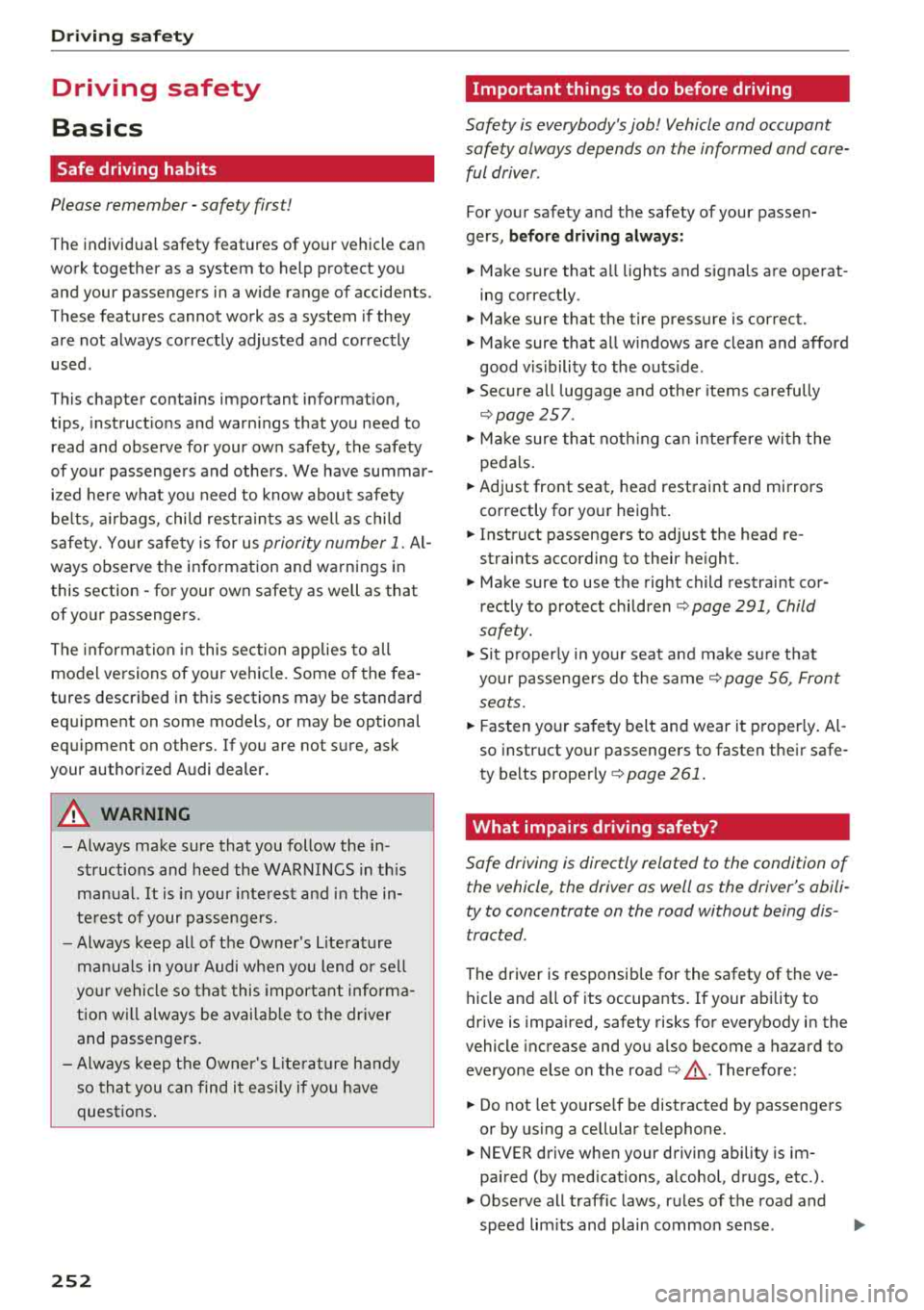
Drivin g saf ety
Driving safety
Basics
Safe driving habits
Please remember -safety first!
The individua l safety features of your vehicle can
work together as a system to help protect you
and your passengers in a wide range of accidents.
These features cannot work as a system if they
are not always correctly adjusted and correctly
used .
This chapter contains important informat ion,
tips, instruct ions and warn ings that you need to
read and observe for your own safety, the safety
of you r passengers and others . We have summar
ized here w hat you need to know about safety
be lts, a irbags, child restra ints as well as child
safety. Yo ur safety is for us priority number 1. Al
ways observe the information and warnings in
this section -for your own safety as we ll as that
of your passengers.
The information in this section applies to all
model versions of your vehicle . Some of the fea
tures described in this sections may be standard
equipment on some models, or may be optional
equ ipment on others. If you are not sure, ask
your author ized Audi dealer.
A WARNING
- Always make sure that you follow the in
structions and heed the WARNINGS in th is
manual.
It is in your inte rest and in the in
te rest of your passengers .
-
-Always keep all of the Owner's L iterature
manuals in yo ur Audi when you lend o r sell
yo ur vehicle so that this import ant informa
t ion w ill alw ays be availab le to the dr iver
and passengers.
- Always keep the Owner 's Lite ra ture han dy
so that you can find it easi ly if yo u have
questions .
252
Important things to do before driving
Safety is everybody's job! Vehicle and occupant
safety always depends on the informed and care
ful driver .
For your safety and the safety of your passen
gers,
bef ore dri ving alw ays:
.. Make sure that a ll lights and signals are operat
ing correctly .
.. Make sure that the tire pressure is correct.
.. Make sure that all windows are clean and afford
good vis ibility to the outs ide .
.. Sec ure all luggage and othe r items ca refully
¢ page 257 .
.. Make sure tha t noth ing ca n interfere wi th the
peda ls .
.. Adjust front seat, head restraint and mirrors
correctly for your height.
.. Instruct passengers to adjust the head re
straints according to their he ight.
.. Make sure to use the right child restraint cor
rectly to protect
children ¢ page 291, Child
safety .
• Sit proper ly in yo ur seat a nd make sure t hat
your passenge rs do the same
¢ page 56, Front
seats .
.. Fasten your sa fety belt and wear it p roperly . Al
so instruct your passengers to fasten their safe
ty be lts
properly ¢ page 261 .
What impairs driving safety?
Safe driving is directly related to the condition of
the vehicle, the driver as well as the driver's abili
ty to concentrate on the rood without being dis
tracted.
The driver is responsib le for the safety of the ve
hicle and a ll of its occupants. If your ability to
drive is impa ired, safety risks for everybody in the
vehicle increase and you a lso become a hazard to
everyone else on the road
¢ _&. . Therefore:
.. Do not let yourse lf be distracted by passenge rs
or by using a cellular telephone .
.. NEVER drive when your driving ability is im
paired (by med ications, alcohol, drugs, etc .) .
.. Observe all traffic laws, rules of the road and
speed lim its and plain common sense .
.,.
Page 256 of 392
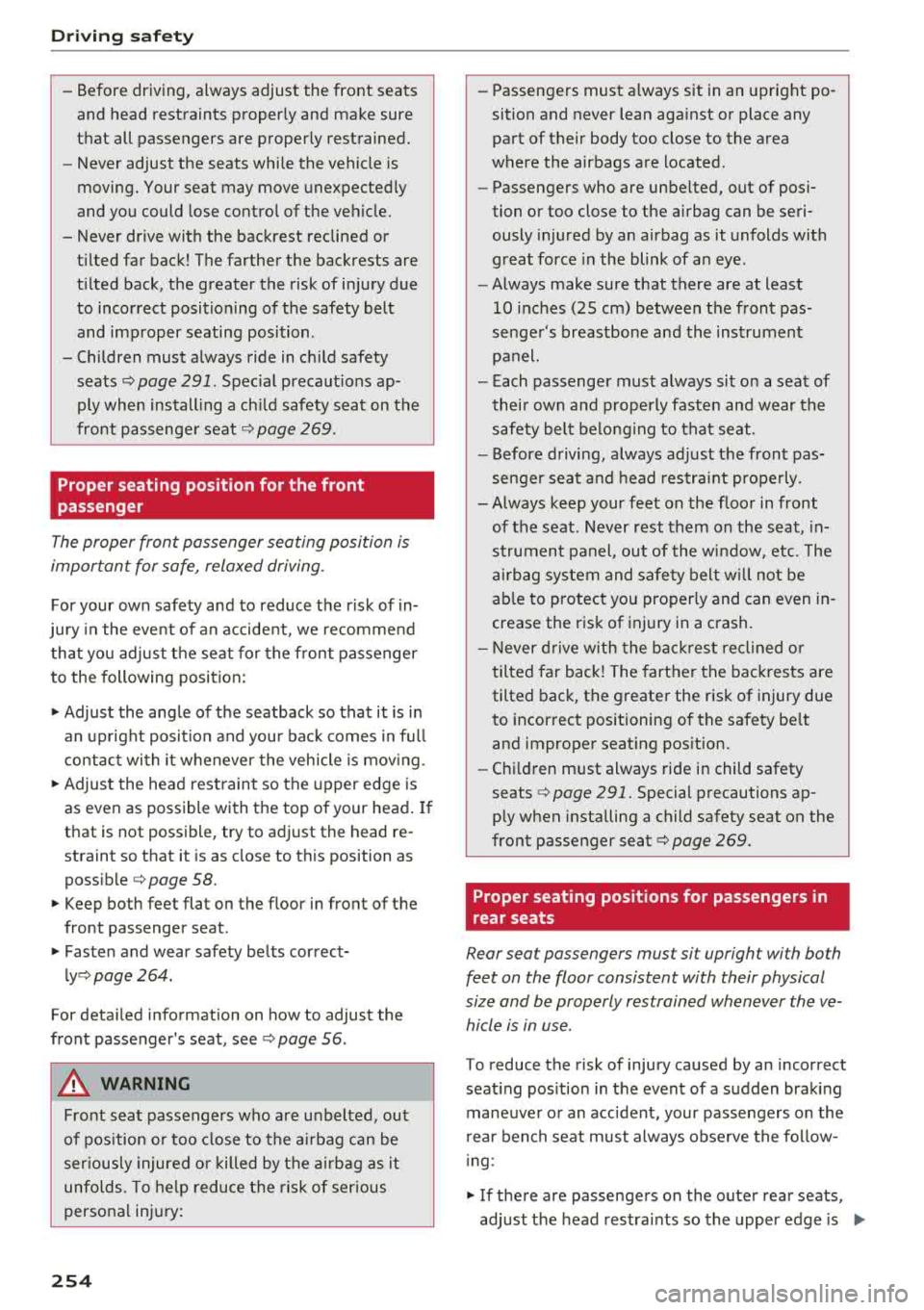
Driving safety
-Before driving, always adjust the front seats
and head restraints properly and make sure
that all passengers are properly restrained.
- Never adjust the seats while the vehicle is
moving. Your seat may move unexpectedly
and you could lose control of the vehicle.
- Never drive with the backrest reclined or tilted far back! The farther the backrests are
tilted back, the greater the risk of injury due
to incorrect positioning of the safety belt
and improper seating position .
- Children must always ride in child safety
seats¢ page 291 . Special precautions ap
ply when installing a child safety seat on the
front passenger seat
c:> page 269.
Proper seating position for the front
passenger
The proper front passenger seating position is
important for safe, relaxed driving.
For your own safety and to reduce the risk of in
jury in the event of an accident, we recommend
that you adjust the seat for the front passenger
to the following position:
.,. Adjust the angle of the seatback so that it is in
an upright position and your back comes in full
contact with it whenever the vehicle is moving .
... Adjust the head restraint so the upper edge is
as even as possible with the top of your head. If
that is not possible, try to adjust the head re straint so that it is as close to this position as
possible¢ page 58.
... Keep both feet flat on the floor in front of the
front passenger seat .
.,. Fasten and wear safety belts correct
ly¢ page 264.
For detailed information on how to adjust the
front passenger's seat, see
¢ page 56 .
A WARNING
Front seat passengers who are unbelted, out
of position or too close to the airbag can be
seriously injured or killed by the airbag as it
unfolds. To help reduce the risk of serious
personal injury:
254
- Passengers must always sit in an upright po
sition and never lean against or place any
part of their body too close to the area
where the airbags are located.
- Passengers who are unbelted, out of posi
tion or too close to the airbag can be seri
ously injured by an airbag as it unfolds with
great force in the blink of an eye.
- Always make sure that there are at least
10 inches (25 cm) between the front pas
senger's breastbone and the instrument
panel.
- Each passenger must always sit on a seat of
their own and properly fasten and wear the
safety belt belonging to that seat.
- Before driving, always adjust the front pas
senger seat and head restraint properly.
- Always keep your feet on the floor in front
of the seat. Never rest them on the seat, in
strument panel, out of the window, etc. The
airbag system and safety belt will not be
able to protect you properly and can even in
crease the risk of injury in a crash.
- Never drive with the backrest reclined or
tilted far back! The farther the backrests are
tilted back, the greater the risk of injury due
to incorrect positioning of the safety belt
and improper seating position.
- Children must always ride in child safety
seats ¢ page 291. Special precautions ap
ply when installing a child safety seat on the
front passenger seat
c::> page 269.
Proper seating positions for passengers in
rear seats
Rear seat passengers must sit upright with both
feet on the floor consistent with their physical
size and be properly restrained whenever the ve
hicle is in use.
To reduce the risk of injury caused by an incorrect
seating position in the event of a sudden braking
maneuver or an accident, your passengers on the
rear bench seat must always observe the follow
ing :
... If there are passengers on the outer rear seats,
adjust the head restraints so the upper edge is
.,.
Page 257 of 392
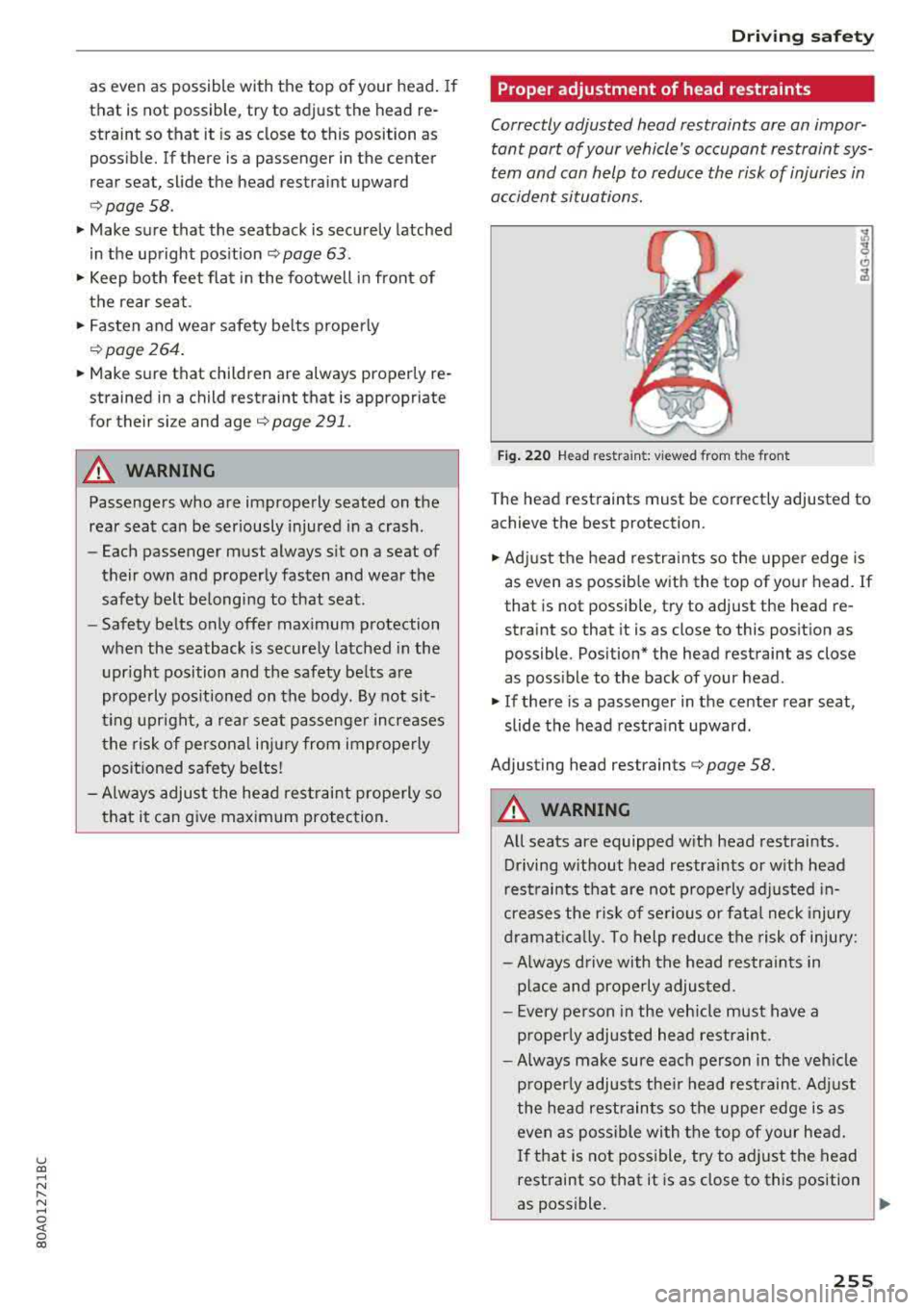
u co ..... N r-N .....
~ 0 co
as even as possible with the top of your head. If
that is not possible, try to adjust the head re
straint so that it is as close to this position as
possible. If there is a passenger in the center
rear seat, slide the head restraint upward
c:>page 58 .
• Make sure that the seatback is securely latched
in the upright pos ition
r:::;, page 63 .
• Keep both feet flat in the footwell in front of
the rear seat .
• Fasten and wear safety be lts properly
,:;;;,page 264.
• Make sure that children are always properly re
strained in a child restraint that is appropriate
for their size and
ager:::;, page 291 .
A WARNING
Passengers who are improperly seated on the
rear seat can be seriously injured in a crash.
- Each passenger must always sit on a seat of
their own and properly fasten and wear the
safety belt belonging to that seat .
- Safety belts only offer max imum p rotection
when the seatback is securely latched in the
upr ight position and the safety be lts are
prope rly pos itioned on the body. By not sit
t ing upright, a rea r seat passenger increases
the risk of personal in jury from improperly
posit ioned safety belts !
- Always adjust the head rest raint properly so
that it can g ive maximum protection.
Dri ving safety
Proper adjustment of head restraints
Correctly adjusted head restraints are an impor
tant part of your vehicle's occupant restraint sys
tem and can help to reduce the risk of injuries in
accident situations.
F ig . 2 2 0 Head restraint: v iewed from t he front
The head restraints must be correctly adjusted to
achieve the best protection.
• Adjust the head restraints so the upper edge is
as even as possib le with the top of your head. If
that is not possible, try to adjust the head re
straint so that it is as close to this position as
possible . Position* the head restraint as close
as possible to the back of your head.
• If there is a passenger in the center rear seat,
slide the head restra int upward.
Adjusting head restraints
r:::;, page 58.
A WARNING
All seats are equipped with head restraints .
Driving w ithout head restraints or w ith head
r est raints that are not properly adjusted in
creases the r is k of se rious or fata l neck injury
dramat ic al ly. To help reduce the risk of inju ry:
- Always d rive with the head restra ints in
p lace and properly adjusted.
- Every pe rson in the veh icle must have a
p roperly adjusted head restraint.
- Always make sure each person in the veh icle
p roperly adjusts the ir head restraint. Adj ust
the head restraints so the upper edge is as
even as possible wi th the top of your head.
I f that is not poss ible, try to ad just the head
rest raint so that it is as close to this position
as poss ible.
Ill>
255
Page 258 of 392

Drivin g saf ety
- Never attempt to adjust head restraint
wh ile driving. If you have dr iven off and
must adjust the driver headrest for any rea
son, first stop the vehicle safely before at
tempting to ad just the head restra int.
- Children must always be properly restrained
in a child restraint that is appropriate for
their age and size
c> page 291 .
Examples of improper seating positions
The occupant restraint system can only reduce
the risk of injury if vehicle occupants are properly
seated .
Improper seating positions can cause serious in
jury or deat h. Safety belts can only work when
they are properly positioned on the body . Im
proper seating positions reduce the effect iveness
of safety belts and w ill even increase the r isk of
i n ju ry and death by moving the safety be lt to crit
ical a reas of t he body. Improper seat ing posit ions
a lso increase the risk of serious injury and dea th
when an airbag deploys and strikes an occupant
who is not in the proper seating position. A driver is responsib le for the safety of all vehicle occu
pants and especially for children. Therefore :
~ Never allow anyone to assume an incorrect
seating position when the vehicle is being used
c> & .
The fo llowing bulletins list only some sample po
sitions that wi ll increase the risk of serio us inj ury
and death. Our hope is that these examples will
make you more aware of seating posit ions that
are dangerous.
The refore, when ever th e vehicle i s mo ving :
-never stand up in the vehicle
- never s tand on the seats
- never knee l on the seats
- never r ide with the seatback reclined
- never lie down on the seats
- never lean up against the instrument pane l
- never sit on the edge of the seat
- never sit sideways
- never lea n ou t t he w indow
- never put yo ur feet out the window
256
-never put your feet on the instrument panel
- neve r rest your feet on the seat c ushion or bac k
o f the seat
- neve r ride in the footwell
- never ride in the cargo area
.8, WARNING
Imp roper seating positions in cr ease the risk
of ser ious personal inju ry and dea th whenever
a veh icle is being used.
- Always make sure that all veh icle o ccupants
s tay in a proper sea ting posit ion and a re
proper ly restrained whenever the vehicle is
being used .
Pedal area
Pedals
The pedals must always be free to move and
must never be interfered with by a floor mat or
any other object.
Make sure that all pedals move free ly without in
terference and that nothing prevents them from retur ning to their or ig inal pos itions .
Only use floor mats that leave the pedal area free
and can be secured with floor mat fasteners.
If a bra ke circuit fails, increased brake pedal trav
e l is req uired to bring the vehicle to a fu ll stop.
.8, WARNING
Pedals that cannot move freely can cause loss
of vehicle contro l and increase the r isk of seri
ous injury.
- Never p lace any objects in the driver's foot
wel l. An object could get into the pedal area
and interfere with pedal funct ion. In case of
sudden braking or an acc ident, you would
no t be able to brake o r acce le rate!
- Always make sure that nothing can fall or
move into the driver's footwell.
Page 260 of 392
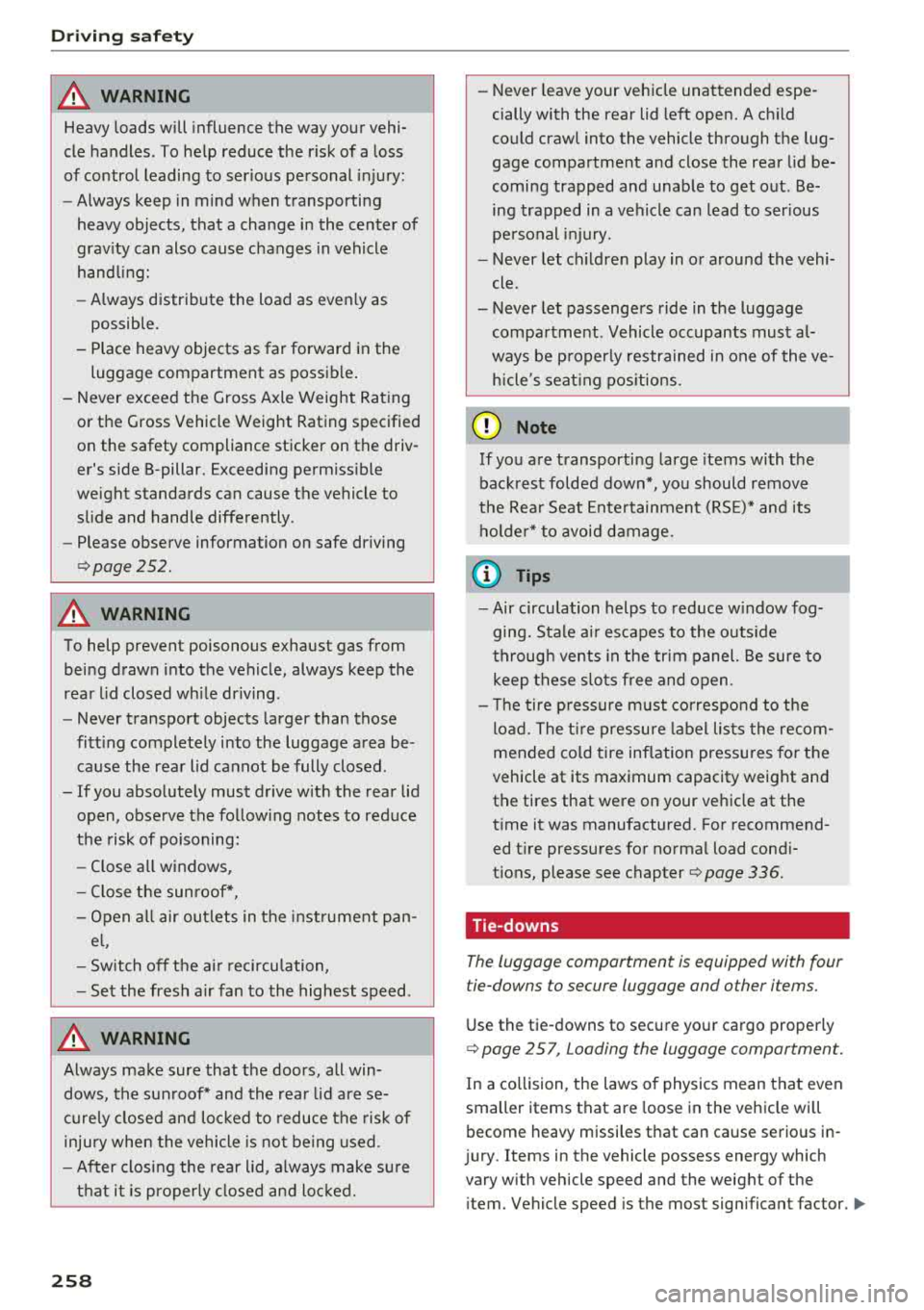
Driving safety
A WARNING
Heavy loads will influence the way your vehi
cle handles . To help reduce the risk of a loss
of control leading to serious personal injury:
- Always keep in mind when transporting
heavy objects, that a change in the center of
gravity can also cause changes in vehicle
handling:
- Always distribute the load as evenly as
possible.
-Place heavy objects as far forward in the
luggage compartment as possible.
- Never exceed the Gross Axle Weight Rating
or the Gross Vehicle Weight Rating specified
on the safety compliance sticker on th e driv
er's side B-pillar. Exceeding permissible
weight standards can cause the vehicle to
slide and handle differently .
- Please observe information on safe driving
<=) page 252.
A WARNING
To help prevent poisonous exhaust gas from
being drawn into the vehicle, always keep the
rear lid closed while driving .
- Never transport objects larger than those
fitting completely into the luggage area be cause the rear lid cannot be fully closed .
- If you absolutely must drive with the rear lid
open, observe the following notes to reduce
the risk of poisoning:
- Close all windows,
- Close the sunroof*,
-Open all air outlets in the instrument pan-
el,
- Switch off the air recirculation,
- Set the fresh air fan to the highest speed .
A WARNING
Always make sure that the doors, all win
dows, the sunroof* and the rear lid are se
curely closed and locked to reduce the risk of
injury when the vehicle is not being used .
-After closing the rear lid , always make sure
that it is properly closed and locked.
258
-Never leave your vehicle unattended espe
cially with the rear lid left open. A child
could crawl into the vehicle through the lug
gage compartment and close the rear lid be
coming trapped and unable to get out . Be
ing trapped in a vehicle can lead to serious
personal injury.
- Never let children play in or around the vehi
cle .
- Never let passengers ride in the luggage
compartment . Vehicle occupants must al
ways be properly restrained in one of the
ve
hicle 's seating positions.
@ Note
If you are transporting large items with the
backrest folded down*, you should remove
the Rear Seat Entertainment (RSE)* and its
holder* to avoid damage.
© Tips
-Air circulation helps to reduce window fog
ging. Stale air escapes to the outside
through vents in the trim panel. Be sure to
keep these slots free and open .
-The tire pressure must correspond to the
load. The tire pressure label lists the recom
mended cold tire inflation pressures for the
vehicle at its maximum capacity weight and
the tires that were on your vehicle at the
time it was manufactured. For recommend ed tire pressures for normal load condi
tions, please see chapter
Q page 336 .
Tie-downs
The luggage compartmen t is equipped with four
t ie-downs to secure luggage and o ther i tems.
Use the tie-downs to secure your cargo properly
Qpage 25 7, L oading the luggage compartment.
In a collision , the laws of physics mean that even
smaller items that are loose in the vehicle will
become heavy missiles that can cause serious in
jury. Items in the vehicle possess ene rgy which
vary with vehicle speed and the weight of the
item . Vehicle speed is the mos t significant fac tor .
..,.
Page 263 of 392

u co ..... N r--N ..... 0 <( 0 00
Safety belts
General information
Always wear safety belts!
Wearing safety belts correctly saves lives!
This chapter exp lains why safety be lts are neces
sary, how they work and how to adjust and wear
them correctly.
• Read all the information that follows and heed
all of the instructions and WARNINGS.
A WARNING
Not wearing safety belts or wearing them im
properly increases the risk of serious personal
injury and death.
- Safety belts are the s ingle most effective
means ava ilable to reduce the risk of serious
injury and death in automobile accidents.
For your protection and that of your passen
gers, always correctly wear safety belts
when the vehicle is moving.
-Pregnant women, injured, o r physically im
paired persons must also use safety belts.
Like all vehicle occupants, they are more
like ly to be seriously injured if they do not
wear safety belts. The best way to protect a
fetus is to protect the mother
-throughout
the entire pregnancy.
Number of seats
Your Aud i has a total of five seating positions:
two in the front and three in the rear. Each seat
ing position has a safety belt.
A WARNING
Not wearing safety belts or wear ing them im
properly increases the risk of serious personal
inju ry and death.
- Never strap more than one person, includ
ing small children, into any belt.
It is espe
cia lly dangerous to place a safety belt over a
child sitt ing on you r lap.
- Never let more people ride in the vehicle
than there are safety belts available.
Safety belts
- Be sure everyone riding in the vehicle is
properly restrained with a separate safety
belt or child restraint.
Safety belt warning light
Your vehicle has a warning system for the driver
and front seat passenger to remind you about the importance of buckling-up.
Fig. 222 Safety belt warn ing ligh t in the instrument clus ·
te r - en larged
Before driving off, always:
• Fasten your safety belt and make sure you are
wearing it properly.
;;i;
• Make sure that your passengers also buckle up
and properly wear their safety belts.
• Protect ch ildren with a child restraint system
appropr iate for the size and age .
The warning light . in the instrument cluster
lights up when the ignit ion is switched on as a re
minder to fasten the safety belts . In add ition,
you w ill hear a warn ing tone for a certain period
of time.
Fasten your safety belt and make sure that your
passengers also properly put on their safety
belts.
A WARNING
-
- Safety belts are the single most effect ive
means available to red uce the risk of serious
i njur y and death in automobile accidents.
F or your protection and that of yo ur passen
gers, a lways correct ly wear safety belts
when the vehicle is moving .
- Fail ure to pay attention to the warning light
that comes on cou ld lead to personal injury.
261